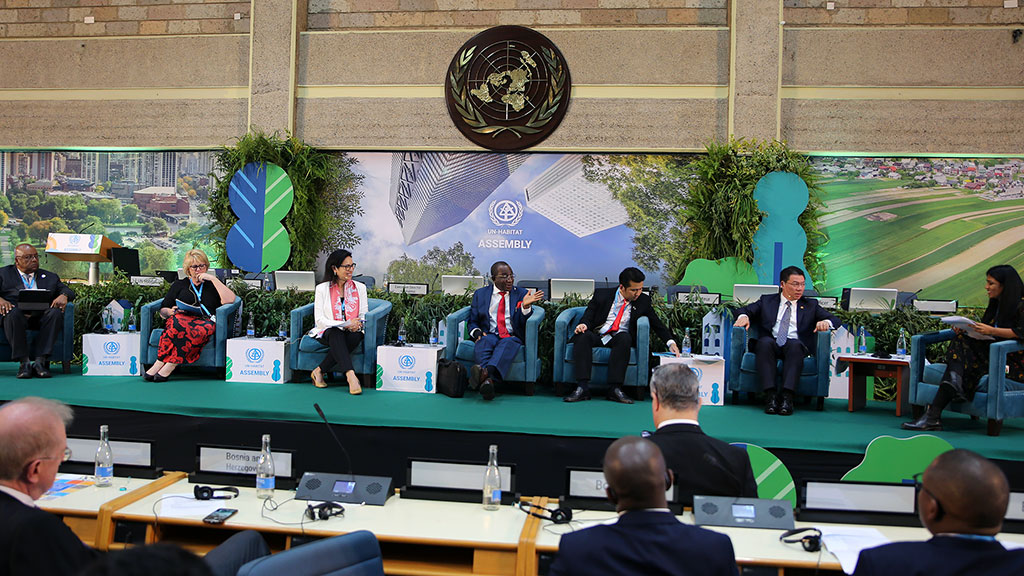Why Designing for the Human Experience Is Key to Advancing SDG Goals
June 14, 2023 | By Diane Hoskins
Last week, as a guest of the United Nations, I traveled to Nairobi, Kenya to speak at the Second Assembly of UN-Habitat, a United Nations agency dedicated to building a better urban future for all.
Delegates convened to discuss the session’s theme, “Achieving the Sustainable Development Goals (SDGs) in Times of Global Crises,” and explore the key challenges and enablers affecting SDG achievement, and how national and subnational governments and stakeholders can work together to localize these goals.
The Sustainable Development Goals, adopted by the UN in 2015, are a universal call to action to end poverty, protect the planet, and ensure that by 2030 all people enjoy peace and prosperity – but essentially, the SDGs are about designing great communities around the world. [Click here to learn more about the SDGs.]
While in Nairobi, I had the privilege of meeting with over 50 government, industry, and community leaders in a series of bilateral, multilateral, and roundtable events. These meetings offered critical insight as to how leaders from Kenya, Nigeria, Ghana — and across Africa — are working to build great communities across the continent.
The energy and optimism in Nairobi are palpable — and everyone feels it. As I reflect on my trip and everyone I met, three big themes emerge:
1. People-focused design can unlock potential in the world’s fastest growing cities — many of which are in Africa.
In times of radical change and crisis, we can leverage design for positive impact. The creative sector will play a pivotal role as we partner with governments, civil society, and other private sector players to foster urban innovation and transformation.
By 2050, Africa will be home to no less than seven megacities with populations of 10 million or more. Many of these cities face challenges associated with rapid urbanization, such as lack of infrastructure, poor sanitation, and climate change induced threats. We must look at the long-term human impact of design to enable the change we seek to improve lives and create vibrant livable cities.
2. Design is THE critical enabler for sustainable development goals.
Money and policy are the most frequently cited enablers of sustainable development goals, but money is wasted, and policy becomes ineffective if we fail to include design as a critical enabler of sustainable development goals. Design can inspire investment, influence policy, and bring together stakeholders in such a way that it promotes scalability of the SDGs.
It’s easy to view the specific SDGs as a checklist, but the spirit of the SDGs is about designing great communities where the human experience of live, work, play is elevated. And, ultimately, people experience change on a local level, and that’s where design is so critical. SDGs aim to improve the quality of life, and it’s imperative that governments and stakeholders use design to localize the SDGs and create impact that people will feel on a personal level.
Design solutions can integrate the objectives of multiple SDGs in a single concept, helping strike an economic balance by getting more done with less resources and creating a tangible vision for change that people can aspire towards.
3. The real estate sector can have immense scalable impact on climate change in the Global South.
The Global South is increasingly vulnerable to climate change as communities navigate preparing for and responding to natural disasters and other climate-related events with far fewer resources. These geographic challenges exhibit a pronounced opportunity to leverage design to create scalable solutions.
The built environment is responsible for some 40% of all greenhouse gas emissions. The real estate industry is uniquely positioned to make a sizeable, scalable impact in the Global South and other developing countries. As the largest architecture and design firm in the world, we have committed to strive for 100% net zero design on all our projects by 2030. We chose this goal because it is the right thing to do, but also because we know that this commitment will impact the industry at scale. As we specify billions of dollars of net zero construction materials and systems, manufacturers will be required to rise to the occasion and decarbonize the products we wish to use.
Gensler will once again attend the United Nations Climate Change Conference, hosted in Dubai later this year, and we will use our presence at COP28 and our stature in the industry to lead the conversation on people-focused design and decarbonization of the built environment.
For media inquiries, email .

